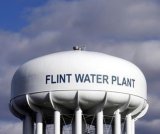EPA Research in Michigan
EPA researchers are working hard to protect communities across the nation. Learn about some of the work EPA researchers are doing in Michigan.
-

- Lead Contamination Support in Flint
- Studying Real-World Lead Pipes in EPA Research
- Using Water Filters to Reduce Lead in Drinking Water
- Community-Led Initiative Aims to Enhance Equity in Grand Rapids Watershed
- Air Sensor Loan Programs: Promoting Air Quality Education
- Real-Time Water Distribution System Analysis
- Sampling and Analysis of PFAS in at Electroplating Facilities
- Predicting Water Quality at Beaches
- Evaluating Technologies to Quantify Landfill Air Emissions
- EPA Researchers Share Lessons Learned from Participatory Science Research Projects
- Tackling the Ozone Issue on Lake Michigan’s Shores
- Living Close to Roadways: Health Concerns and Mitigation Strategies
- Contaminants Caught in a Spider's Food Web
For more EPA work, see EPA in Michigan.
Helping Community Drinking Water Systems Find Cost-Effective Solutions to Treatment Challenges
Emerging contaminants, such as per- and polyfluoroalkyl substances (PFAS), are challenging to drinking water systems across the country. Effective treatment for emerging contaminants can be unknown, difficult, and extremely costly. Working with the state of Michigan, EPA researchers are providing technical assistance to a very small community water system with PFAS concerns to help them identify optimal, cost-effective treatment methods and optimize the long-term operation of their chosen technology. These efforts will also be used to develop best practices and performance and cost estimate tools so water utilities across the country can make informed treatment and operational choices.
Lead Contamination Support in Flint

EPA’s Office of Research and Development (ORD) created the Reachback for Emergency Response (RACER) effort to provide ready access to all of ORD’s technical resources during an environmental incident. Learn more about how RACER was used to coordinate technical support needs identified by the Agency’s responders during the response to the Flint drinking water crisis.
EPA researchers are also researching the dynamics of water chemistry, treatment, and infrastructure to help facility managers and local communities — including Flint — keep lead out of drinking water. Read Scaling Back: EPA Researchers Help Communities Protect Drinking Water Systems from Lead.
Studying Real-World Lead Pipes in EPA Research
If a water system has lead service lines, limiting corrosion is a necessary step to reduce lead exposure from drinking water. EPA and other scientists use predictive solubility models to try and help drinking water systems pick the right corrosion control treatment that fits their system’s individual needs. EPA researchers looked at how well these models were predicting what is happening in the real world by using data and real-world pieces of piping from EPA’s Region 5 — comprised of Minnesota, Wisconsin, Michigan, Illinois, Indiana, and Ohio. Read EPA Researchers Help Water Systems Keep Lead out of Drinking Water.
Using Water Filters to Reduce Lead in Drinking Water
ORD supported the City of Benton Harbor in 2018 when lead levels in the drinking water supply sparked health concerns. In response, the Michigan Department of Health and Human Services (MDHHS), through the Berrien County Health Department, distributed faucet-mounted and pitcher filters to reduce the level of lead in tap water. EPA researchers coordinated three studies along with local partners (MDHHS, Michigan Department of Environment, Great Lakes, and Energy; the City of Benton Harbor; and Lake Michigan College). The studies helped to ensure residents that the filters, when properly installed and used, removed lead from drinking water as expected.
Read the final report: Benton Harbor Drinking Water Study (2023)
Community-Led Initiative Aims to Enhance Equity in Grand Rapids Watershed Resilience
EPA scientists work with EPA's Urban Waters Federal Partnership Program to research ways to support communities in making equity central to their resilience planning. Read about workshops EPA helped Michigan’s Lower Grand River Organization of Watersheds organize with partner organizations to gather input on community concerns around resilience and actions that could improve resilience.
Air Sensor Loan Programs: Promoting Air Quality Education
As interest in local air quality increases, so does the demand for air sensors—the smaller, lower cost, non-regulatory technologies that measure air quality. However, air sensors are not always accessible to everyone. EPA worked with the Los Angeles Public Library to start a pilot air sensor loan program that then expanded to the Midwest, to provide local communities in Michigan with access to air sensors and guidance on using them. Read Air Sensor Loan Programs: Promoting Air Quality Education by Bringing Sensors to You.
Real-Time Water Distribution System Analysis
EPA's tool EPANET-RTX gives water utilities the necessary tools to enhance system operations including emergency response and improved operations, e.g., better pressure management, leak detection and water quality. EPANET-RTX has been tested or demonstrated in several locations including Ohio, Colorado, Florida, Kentucky, and Michigan.
Sampling and Analysis of PFAS in at Electroplating Facilities
At the request of Michigan Department of Environment, Great Lakes, and Energy (EGLE), ORD conducted laboratory analysis of fume suppressant products and effluent from 11 Michigan chrome plating facilities to investigate PFAS. EPA scientists used targeted and non-targeted analysis laboratory methods to identify and measure concentrations of PFAS. EGLE used the information provided by ORD to publish a report and host a webinar targeted toward the metal finishing industry to provide better understanding of sources of PFOS and how to reduce the amount of this pollutant released into the environment.
Living Close to Roadways: Health Concerns and Mitigation Strategies

Living close to roadways can pose health risks related to pollution from traffic. EPA researchers looked at ways to mitigate these risks, including placing vegetation barriers along roads to reduce pollution. They applied their research at a community park Detroit. Read Living Close to Roadways: Health Concerns and Mitigation Strategies.
Learn about the results of the Detroit pilot study.
Predicting Water Quality at Beaches
To protect public health, beach managers need to continually assess the level of potentially harmful microbes in the water. Traditional culture-based testing methods can take 24 hours to get results – preventing same-day, proactive beach closures and leaving many recreational swimmers open to sickness or infection, or potentially close a beach needlessly and incur economic losses. ORD's Virtual Beach software offers a solution. Virtual Beach facilitates efforts to support the local economy while protecting the health of residents. Virtual Beach is used to assist in advisory issuances in the Great Lakes states and to forecast water conditions in numerous locations, including Michigan.
Evaluating Technologies to Quantify Landfill Air Emissions
As waste in landfills decomposes, it produces emissions including methane, nonmethane organic compounds, and hazardous air pollutants. At the request of the state of Michigan and EPA Region 5, ORD researchers evaluated an alternative approach for conducting surface emission measurements (SEMs) at landfills using drone technology. This work resulted in development of an alternative measurement method that allows for routine use of the drone for conducting quarterly SEMs as required by the Clean Air Act. This method (OTM 51) is now in routine use across the U.S.
EPA Researchers Share Lessons Learned from Participatory Science Research Projects
Environmental Health Assessments (EHAs) are used to better understand the range of possible effects of environmental factors on a community’s health and wellbeing. These assessments are even more effective when researchers involve the community through citizen science. Using decades of experience conducting citizen science-based EHAs, EPA scientists published a paper on advice and frequently asked questions to help other communities conduct these assessments. As part of a project in Saginaw Valley, Michigan, EPA researchers and partners in EPA Region 5 built on the advice and frequently asked questions component of the research to develop a database of environmental actions that address health effects from different pollutants. Read EPA Researchers Share Lessons Learned from Citizen Science Research Projects.
Tackling the Ozone Issue on Lake Michigan’s Shores
EPA scientists collaborated with multiple agencies for the Lake Michigan Ozone Study — a field study aimed at better understanding ozone chemistry and meteorology along the Wisconsin-Illinois Lake Michigan shoreline using a combination of aircraft, ground-based, and ship-based measurements. Read By Air, Land and Sea: Tackling the Ozone Issue on Lake Michigan’s Shores.
Contaminants Caught in a Spider's Food Web
Using orb weaving spiders commonly found near water bodies, EPA scientists tracked the movement of contaminants from the aquatic ecosystem of Lake Hartwell, South Carolina to the terrestrial ecosystem that surrounds it. following on the success at Lake Hartwell, the scientists also sampled spiders at Manistique Harbor to further research contaminated sediments and ongoing clean up operations.
